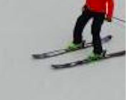....Unskillful skiers who use leg muscles get pain in the quads very quickly. Pain in the quads is a sign of wrong, effortful skiing technique. I know it is hard to understand without knowing the true biomechanics of skiing.....
No, it is not hard to understand without knowing the true biomechanics of skiing. Every ski instructor I know understands this. It's not special knowledge only available to certain specialists with degrees in biomechanics.
If a skier's quads are quaking at the end of a day of skiing, that skier has been skiing in the back seat. If your quads after skiing are acting like you've been doing wall-sits, then you've been doing the equivalent of wall-sits while skiing.
Wall-sit:
The important thing to see is that the lower legs rise up at 90º to the surface, with all of the body behind the feet. The quads will be raging. At least this woman has the wall to help support her weight behind her feet so she stays upright.
 Back seat skier with arms forward:
Back seat skier with arms forward:

The fact that the arms are forward
does not erase the issue. This skier
is dong a wall-sit while skiing. The
lower legs rise at 90º to the surface
below the feet. The tails of the skis
help the skier stay upright, as does
the wall in the wall sits.
The quads will be raging.
Back seat skiers without the arms forward:


Same issue. Flaminging quads. These skiers need to bend forward at the ankles in order to get their body weight centered over their feet.







 Yes, I love that you point out the difference between traversing to find a different/better line rather than being scared of not being able to turn, that really describes the different feelings perfectly. I like that they look visibly different in intention.
Yes, I love that you point out the difference between traversing to find a different/better line rather than being scared of not being able to turn, that really describes the different feelings perfectly. I like that they look visibly different in intention. 
